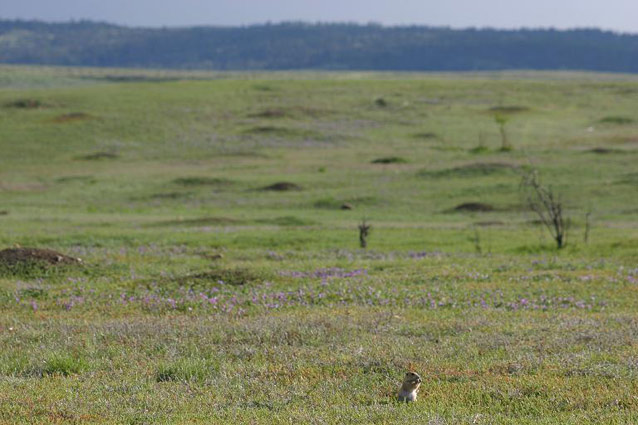The historic range of the black-tailed prairie dog extended to the east, north, and south of the combined ranges of the white-tailed, Gunnison’s, and Utah prairie dogs (Hoogland 2006a). Overlap in the ranges of the species is so small that location can be used to identify species. Mexican and black-tailed prairie dogs generally live at lower elevations than the other species (Hoogland 2006a).
Black-tailed Prairie Dogs
Living on grassy plains or prairies, the black-tailed prairie dog's historic range included parts of Canada, Mexico, and eleven U.S. states. Today it occurs from extreme south-central Canada to northeastern Mexico and from the Rocky Mountains east to about the 98th meridian (which passes through the Dakotas, Nebraska, Kansas, etc. on south), still inhabiting parts of eleven states. Six of these states—Arizona, Colorado, Kansas, New Mexico, Oklahoma, and Texas—are in the four NPS Inventory and Monitoring (I&M) Networks of the American Southwest, and five of the states—Montana, Nebraska, North Dakota, South Dakota, and Wyoming—are outside of the area. Of the area of NPS-managed lands occupied by the black-tailed prairie dog, the vast majority are in three parks (Badlands NP, Theodore Roosevelt NP, and Wind Cave NP) outside of the Southwest (Sidle et al. 2006).
Estimates of prairie dog populations are usually based on the amount of occupied habitat, rather than on the number of individual animals (USFWS 2009). Density of black-tailed prairie dogs typically ranges between two and 18 animals per acre, depending on the region, season, and climate. Temporal variations in density may also result from plague, poisoning, or recreational shooting. Historically, black-tailed prairie dogs were thought to have occupied 324,000 to 405,000 km2 (80 to 100 million ac) range-wide. Today, the species is thought to occupy 85,000 km2 (2.1 million ac) of habitat.

USFWS
Within the American Southwest, the black-tailed prairie dog is known to occur within or directly adjacent to several national park units. Within the Southern Plains Network (SOPN), the species occurs at Fort Larned National Historic Site (NHS) (FOLS) in Kansas and Bent’s Old Fort NHS (BEOL) and Sand Creek Massacre NHS (SAND) in Colorado. At SAND, a prairie dog complex occupies approximately 228 acres of the park and is expected to expand if left undisturbed (Sovell 2008).
The black-tailed prairie dog is not known to occur at this time within any parks of the Sonoran Desert Network (SODN), although historically the species occurred at/near Coronado National Monument (NM) (CORO), Fort Bowie NHS (FOBO), and probably Chiricahua NM (CHIR). There is currently a population south of Coronado, in Sonora, Mexico, and there was a recent reintroduction of the species in Sonoita, Arizona (see “Status” section for more details). In the CHDN, there was an attempt to restore prairie dogs at Guadalupe Mountains NP (GUMO), but it was unsuccessful (Sidle et al. 2006). The species also occurred historically at Amistad National Recreation Area (NRA) (AMIS), Carlsbad Caverns NP (CAVE), and possibly Fort Davis NHS (FODA) and White Sands NM (WHSA).
Gunnison’s Prairie Dogs
Gunnison’s prairie dog habitat occurs in four states—Arizona, Colorado, New Mexico, and Utah (Hoogland 2006a; USFWS 2008). Populations of this species occur in either higher elevations (referred to as montane populations) or lower elevations (referred to as prairie populations) (USFWS 2008). The montane habitat occurs in the northeastern portion of the range—in central and south-central Colorado and north-central New Mexico; about 35-40% of the species’ current range consists of this habitat. The prairie habitat occurs in the southwestern portion of the range— in southeastern Utah, southwestern Colorado, northwestern New Mexico, and northern Arizona; about 60-65% of the species’ current range consists of this habitat. In the montane habitat prairie dogs occupy grass-shrub in low valleys and montain medows, and in the prairie habitat prairie dogs occupy shortgrass and midgrass prairies. Of potential habitat within the prairie dog’s range, 43% occurs on private lands, 27% on state and federal lands, and 30% on tribal lands.
Of the four networks in the Southwest, the Gunnison’s prairie dog occurred historically and occurs today primarily within the Southern Colorado Plateau Network (SCPN). Historically, the species occurred within at least ten parks in the SCPN. It presently occurs within El Malpais NM (ELMA), El Morro NM (ELMO), Chaco Culture NHP (CHCU), and Petrified Forest NP (PEFO), and it may occur at Aztec Ruins NM (AZRU), Hubbel Trading Post NHS (HUTR), and Mesa Verde NP (MEVE). Although a few acres of habitat may be inhabited at AZRU, a die-off due to the sylvatic plague occurred in the last decade. Within the SOPN, the species is known to have inhabited Pecos NHP (PECO); however, the habitat is no longer supportive of prairie dogs due to the encroachment of juniper and pinyon.
Prepared by Patricia Valentine-Darby, Southern Plains Network Inventory and Monitoring Program, 2009.
Part of a series of articles titled Prairie Dogs of the American Southwest.
Last updated: May 19, 2015
